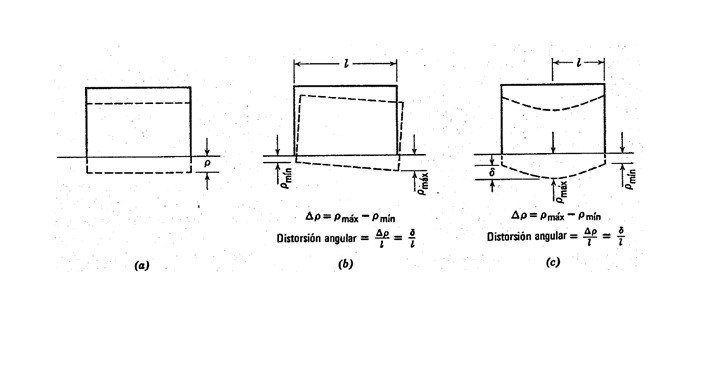
The blog of Alvaro Boiero
"Live as if you were going to die tomorrow. Learn as if you were going to live forever" Mahatma Gandhi

The blog of Alvaro Boiero
geo
"Live as if you were going to die tomorrow. Learn as if you were going to live forever" Mahatma Gandhi
Foundations: differential settlements
The differential settlement δD, is the difference between settlements experienced between two foundations, or between two points of the same foundation. If excessive differential settlement occurs, the functionality of the structure can be significantly affected. Do you want to know more about differential settlement? Keep reading this post...
Differential settlements
In foundations design, once the expected settlement of a foundation has been estimated, two very important aspects must be reviewed: A) whether the settlement of that foundation is lower than the total allowable settlement (see the article Total allowable foundation settlements in this blog); and B) whether the differential settlement between two foundations (or between two points of the same foundation structure, as in the case of slabs or spread footings) is within the allowable range, so that the functionality of the structure is not affected.
Figure 1 illustrates typical cases of settlement of structures, also including some basic definitions.

Figure 1 Types of settlements: (a) uniform settlement; (b) tipping; (c) non-uniform settlement. In the figure: ρ = settlement; Δρ = differential settlement; l = support spacing; Δρ / l = angular distortion (Source: Lambe & Whitman, 1969).
A question that always arises when talking about settlement of structures is the following: why do differential settlements occur? The answer is not simple, but it is possible to mention some factors associated with these settlements:
- Variations in the subsoil profile. Given the enormous heterogeneity of soils, a structure could be supported on soils with different stiffnesses, which would generate unequal deformations in the different foundations of that structure.
- Variations between design loads and service conditions. Even when the foundations are designed to cover service loads, there may be certain differences between actual loads and design loads. Thus, those foundations in which this difference is more significant will suffer greater deformations, generating differential settlements with respect to other foundations of the structure.
- Construction tolerances. The dimensions as built of the foundations may differ from the design dimensions, so the deformation behavior may also vary.
In any case, differential settlements are more important than total settlements, since they generate not only vertical movements of the structures, but also angular distortions that can affect their functionality.
Criteria for allowable differential settlements
The determination of settlement that can generate significant architectural or structural damage is a very complex, highly indeterminate problem. Consequently, the analysis of tolerable settlements and the development of criteria to establish these tolerable settlements were carried out on an empirical basis (Holtz, 1991).
Table 1 summarizes acceptance criteria for total settlement, slope, and differential settlement for different types of structures.
Table 1 Allowable settlements for structures (Source: Sowers, 1962; Perloff & Baron, 1976; Holtz
Type of movement | Case | ρ o Δρ |
Total settlement (ρ) | Drainage | 6 – 12 in |
Acceses | 12 – 24 in | |
Probability of NON-uniform settlement: |
| |
Masonry walls | 1 – 2 in | |
Frame structures | 2 – 4 in | |
Fireplaces, silos, slabs | 3 – 12 in | |
Tilt | Fireplaces, towers | 0,004 h |
Truck roads | 0 01 L | |
Wood stacking | 0,01 L | |
Equipment operations | 0,003 L | |
Turbogenerators | 0,0002 L | |
Craines rails | 0,003 L | |
Roof drainage | 0,01 L – 0,02 L | |
Differential settlements (Δρ) | Masonry walls | 0,0005 L – 0,001 L |
Plaster cracking | 0,001 L | |
Reinforced concrete frame structure | 0,0025 L – 0,004 L | |
Continuous steel portal frame | 0,002 L | |
Simple Steel portal frame | 0,005 L |
L =distance between adjacent columns, or between two points where differential settlement is observed.
Higher allowable values correspond to regular settlement levels; lower permissible values correspond to irregular settlement levels.
Figure 2 summarizes some empirical criteria for buildings commonly used in practice. These criteria are based on the levels of angular distortion at which problems begin to become evident in buildings, or on the spacing between columns.

Figure 2 Allowable settlements for buildings (Source: Holtz, 1991).
As can be seen from the information summarized in Table 1 and Figure 2, when estimating the allowable settlements (total and differential), it is essential to take into consideration the type of structure to be built.
Practical considerations
Another frequent question when facing the process of foundation design in a project is the following: which foundations should be considered to analyze differential settlement?
For buildings, one option is to analyze the foundations of each and every column of the structure, estimate the total settlement in each case, and analyze the differentials between adjacent supports. However, this is not very practical for projects of a certain size, nor in the case of structures supported on slabs or spread footings.
Another option is the one initially proposed by Peck in the 1940s, and recommended by Coduto in 2001 (a fact that proves its validity). This option consists of taking the most loaded foundation, assuming that it will be supported on the most unfavorable part of the soil (i.e., the most compressible), and estimating the total settlement ρ under those conditions. Subsequently, repeat the procedure, but considering the less loaded foundation supported on the stiffest part of the studied terrain. As a last step, determine the differential settlement Δρ expected between these two conditions.
Theoretically, unless there are sectors of greater weakness not identified during the exploration, the value obtained for Δρ would be the maximum possible. Thus, this maximum value should be compared with the criteria shown in Table 1 and Figure 2, and if it is within the allowable range, all building foundations would be expected to meet the criterion.
This methodology, initially proposed for isolated building foundations, can also be applied, conservatively, for slabs and spread footings, assuming that they would be supported on two different soils (the one with higher stiffness conditions and the one with lower stiffness). Thus, it would be possible to simulate what could happen between two sectors of these foundations supported on soils of different stiffness.
In the case of special equipment (such as turbogenerators or radars, for instance) and tanks, the recommendations stipulated by manufacturers and suppliers in relation to the differential and total settlements admissible for each case must be followed.
References
- Coduto, D. (2001) “Foundation Design: Principles and Practices”. Second Edition. Prentice Hall. New Jersey, USA.
- Holtz, R. (1991) “Stress Distribution and Settlement of Shallow Foundations”. Foundation Engineering Handbook. Second Edition. Van Nostrand Reinhold. New York, USA.
- Lambe, W. & Whitman, R. (1969) “Soil Mechanics”. John Wiley & Sons, Inc. New York, USA.
- Terzaghi, K. & Peck, R. (1967) “Soil Mechanics in Engineering Practice”. Second Edition. John Wiley & Sons, Inc. New York, USA.